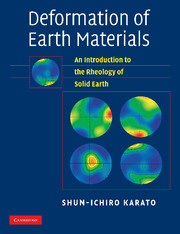Book contents
- Frontmatter
- Contents
- Preface
- Part I General background
- Part II Materials science of deformation
- 4 Elasticity
- 5 Crystalline defects
- 6 Experimental techniques for study of plastic deformation
- 7 Brittle deformation, brittle–plastic and brittle–ductile transition
- 8 Diffusion and diffusional creep
- 9 Dislocation creep
- 10 Effects of pressure and water
- 11 Physical mechanisms of seismic wave attenuation
- 12 Deformation of multi-phase materials
- 13 Grain size
- 14 Lattice-preferred orientation
- 15 Effects of phase transformations
- 16 Stability and localization of deformation
- Part III Geological and geophysical applications
- References
- Materials index
- Subject index
- Plate section
7 - Brittle deformation, brittle–plastic and brittle–ductile transition
Published online by Cambridge University Press: 05 June 2012
- Frontmatter
- Contents
- Preface
- Part I General background
- Part II Materials science of deformation
- 4 Elasticity
- 5 Crystalline defects
- 6 Experimental techniques for study of plastic deformation
- 7 Brittle deformation, brittle–plastic and brittle–ductile transition
- 8 Diffusion and diffusional creep
- 9 Dislocation creep
- 10 Effects of pressure and water
- 11 Physical mechanisms of seismic wave attenuation
- 12 Deformation of multi-phase materials
- 13 Grain size
- 14 Lattice-preferred orientation
- 15 Effects of phase transformations
- 16 Stability and localization of deformation
- Part III Geological and geophysical applications
- References
- Materials index
- Subject index
- Plate section
Summary
Non-elastic deformation is conveniently classified into brittle and plastic (ductile) deformation based on the scale of discontinuous deformation. Although the main focus of this book is plastic (ductile) deformation, some knowledge of brittle deformation is critical to the understanding of rheological stratification of the lithosphere. Also an understanding of brittle to plastic transition is essential for the understanding of the origin of deep and intermediate earthquakes. This chapter provides a brief summary of brittle deformation and the major differences between brittle and plastic deformation. The nature of brittle–plastic transition is discussed based on the different dependence of strength in two regimes on temperature and pressure and other parameters.
Key words micro-cracks, faulting, Coulomb–Navier's law, Byerlee's law, pore fluid pressure, brittle fracture, plastic flow, brittle–ductile transition, semi-brittle deformation, brittle–plastic transition.
Brittle fracture and plastic flow a general introduction
When a stress is applied to a material, a material will deform elastically when the stress is small or when stress is applied at low temperatures (or for a short time). Deformation of a material in this case is due to a small displacement of atoms from their stable positions. Upon applying stress, atoms move to new equilibrium positions instantaneously, and upon the removal of this stress, they move back to their original positions. The nature of elastic deformation and the elastic properties of materials are discussed in Chapter 4.
- Type
- Chapter
- Information
- Deformation of Earth MaterialsAn Introduction to the Rheology of Solid Earth, pp. 114 - 122Publisher: Cambridge University PressPrint publication year: 2008



